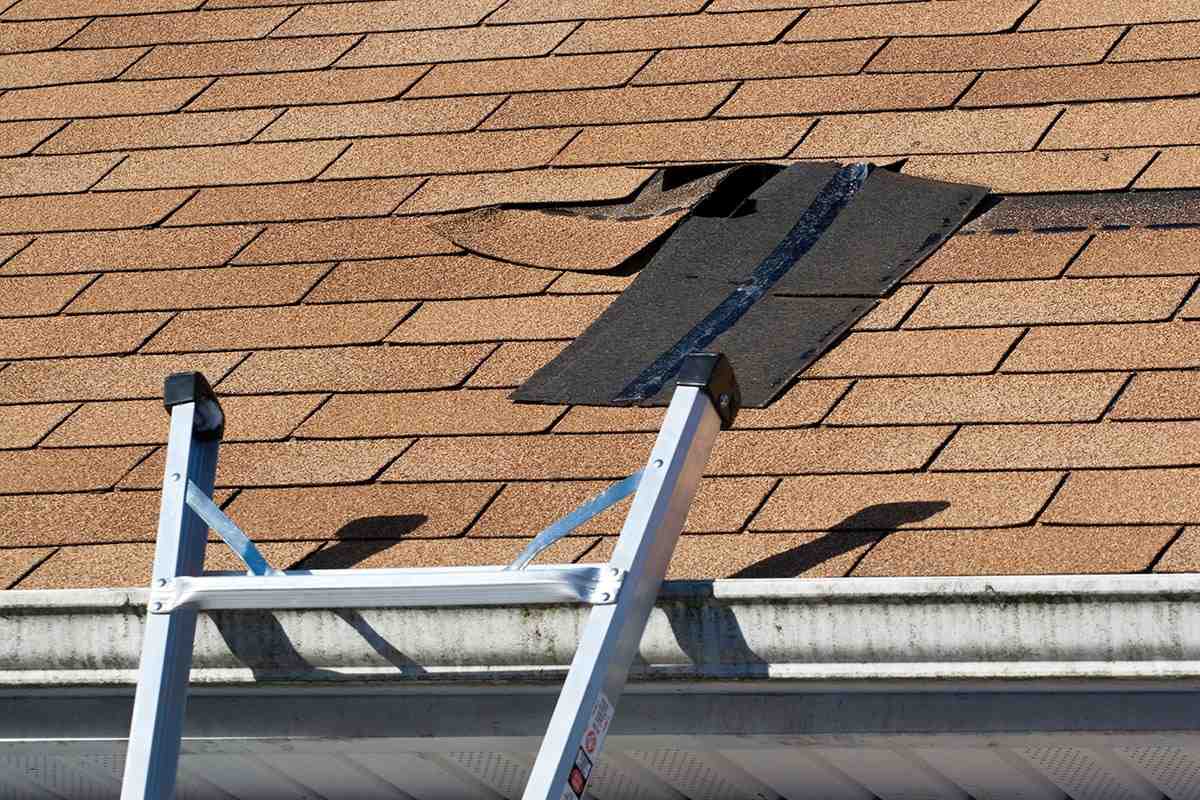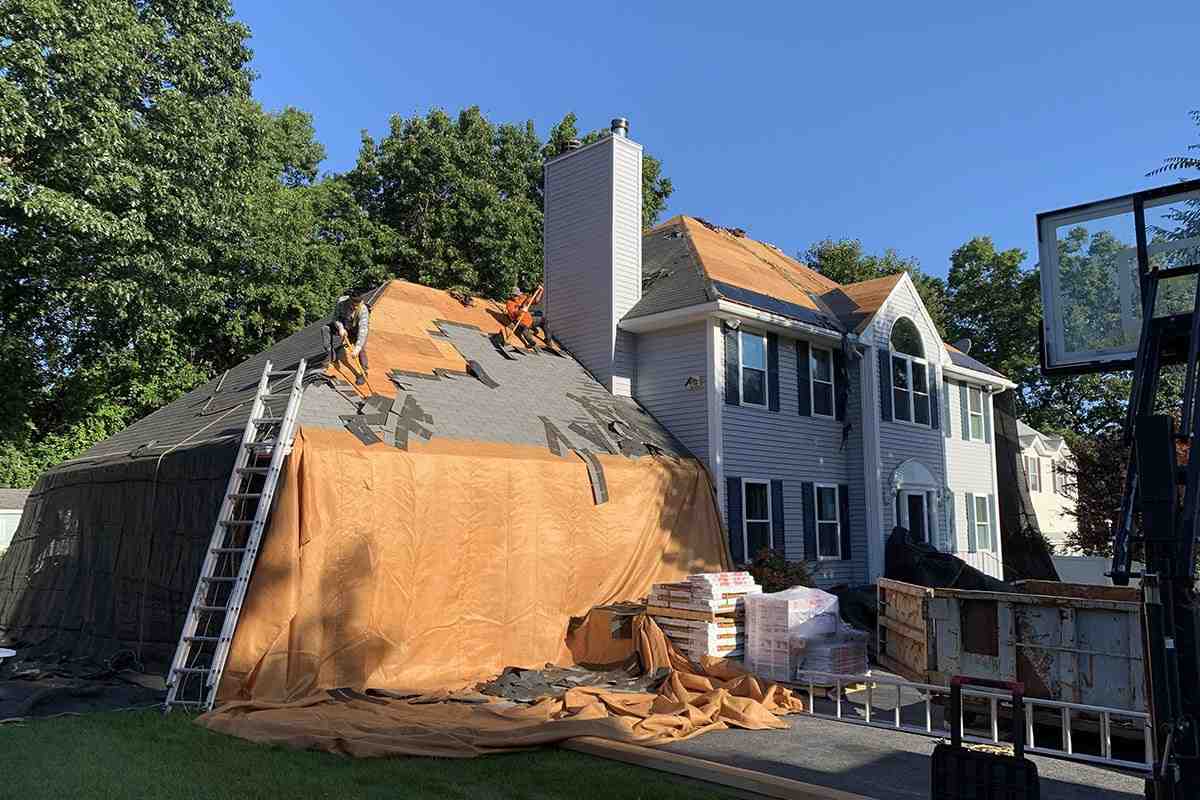Introduction
Roof replacement is a crucial step for maintaining a home’s structure and comfort. It involves removing your existing roof and installing a new one, ensuring that your home remains safe and weatherproof.
- Protection: A new roof protects your home from weather-related damage and improves insulation.
- Value: Updating your roof can increase your home’s market value.
- Efficiency: Modern roofing materials can improve your home’s energy efficiency, potentially lowering heating and cooling costs.
- Safety: Replacing an old or damaged roof can prevent costly water damage and mold growth inside your home.
Roof replacement is not just a repair; it’s an investment in your home’s future. It safeguards against external elements and enhances the overall comfort for all residents. Homeowners should regard this process as a vital part of home maintenance, especially when signs of aging or damage start to appear.
Given its importance, choosing the right materials and a reliable contractor plays a pivotal role in the roof’s longevity and functionality. Opting for quality roofing materials and skilled installation can lead to decades of security and aesthetic appeal.
Understanding Roof Replacement
What is Roof Replacement?
Roof replacement involves completely removing your existing roof down to the bare deck and installing a new one. This includes new shingles, underlayment, and sometimes even new gutters and flashing. It’s not just a patch job; it’s a total renewal to ensure your home stays protected from the elements.
Why is Roof Replacement Necessary?
Over time, roofs wear down due to weather exposure, material degradation, and other environmental factors. A compromised roof can lead to water damage, energy loss, and pest infestations. Replacing your roof when needed helps maintain your home’s structure, efficiency, and comfort.
Signs You Might Need a Roof Replacement
Identifying when you need a new roof is crucial. Here are some clear indicators:
- Curling Shingles: Shingles that curl or buckle are a sign that they’re past their life expectancy.
- Gutter Granules: If you start noticing granules from your shingles accumulating in the gutters, this suggests your shingles are wearing out.
- Cracked Shingles: These can allow water to enter your home, leading to further damage.
- Old Age: If your roof is over 20 years old, it might be time for a replacement, especially if it’s showing other signs of wear.
- Attic Light: Seeing light in your attic? This could mean there are holes or cracks in your roof.
By understanding these aspects, homeowners can make informed decisions about whether to repair or replace their roofing. Each situation might be different based on the age of the roof, the extent of the damage, and environmental conditions affecting the roof. Taking action at the right time can save you from more severe and costly damage in the future.
Roof Replacement Cost Factors
When planning a roof replacement, several factors can affect the overall cost. It’s essential to consider each of these to budget effectively and make informed decisions.
Materials
The choice of roofing materials has a significant impact on the cost. Options range from asphalt shingles, which are among the most affordable, to more premium materials like slate or metal. For instance, asphalt shingles might cost between $8,000 and $17,000 for a 2,000-square-foot home, while metal roofing could range from $14,000 to $30,000 for the same size.
Labor
Labor costs can vary widely depending on the complexity of the job and the experience of the roofing contractors. Complex roofs with steep pitches or multiple levels require more time and specialized skills, which can increase the cost.
Size
The size of your roof directly influences the amount of materials needed and the labor required. Larger roofs will naturally cost more to replace than smaller ones due to the increased volume of materials and manpower needed.
Pitch
The slope or pitch of the roof also affects the cost. Steeper roofs are more challenging to work on and may require additional safety equipment and time, leading to higher labor costs.
Location
Your geographic location can influence the cost of roof replacement. Labor rates, the cost of materials, and even the type of roofing that is best suited for the local climate can vary significantly from one region to another.
Permits
Depending on where you live, you may need to obtain permits before starting a roof replacement. The cost of these permits can vary, but they are necessary to ensure that the roofing project complies with local building codes.
Waste Disposal
Finally, the cost of disposing of your old roofing materials can add to the overall expense of the project. Proper disposal is essential for environmental compliance and can vary in cost depending on the material and local regulations.
By considering these factors, you can better understand the potential costs involved in replacing your roof and plan your budget accordingly. Next, we’ll explore the different roofing materials and their costs to help you choose the best option for your home.
Roofing Materials and Their Costs
When it comes to roof replacement, the choice of material not only affects the appearance and durability of your roof but also significantly impacts the cost. Here’s a breakdown of popular roofing materials and their associated costs:
Asphalt Shingles
Cost: $1-4 per square foot
Asphalt shingles are the most common roofing material due to their cost-effectiveness and ease of installation. They typically last 12-30 years depending on the quality. This makes them a popular choice for many homeowners looking for a balance between cost and durability.
Metal Roofing
Cost: Standing seam: $10-16 per square foot; Metal shingles/shakes: $8-16 per square foot
Metal roofing is known for its durability, lasting 30-50 years, and its ability to withstand severe weather conditions. It’s a great choice for areas prone to wildfires or heavy snowfall. Metal roofs are recyclable, adding an eco-friendly element to their appeal.
Wood Shingles and Shakes
Cost: Shingles: $4-9 per square foot; Shakes: $6-14 per square foot
Wood shingles offer a natural and attractive look but require maintenance to prevent damage from moisture and insects. Wood shakes are thicker and more rugged, providing better insulation and a longer lifespan but at a higher cost. Both types are not recommended in fire-prone areas.
Slate
Cost: $10-30 per square foot
Slate roofing is one of the most durable and long-lasting materials, with a lifespan of 50-150 years. It’s also one of the most expensive options. Slate’s weight and installation difficulty require specialized skills, adding to the overall cost.
Clay Tiles
Cost: $10-18 per square foot
Clay tiles are favored for their durability and ability to withstand heat, making them ideal for hot climates. They can last 50-100 years. The Spanish-style red tile is a popular choice, though it is heavy and requires a strong structural support system.
Concrete Tiles
Cost: $10-20 per square foot
Concrete tiles offer similar benefits to clay but at a slightly lower cost. They are very durable and can also last as long as clay tiles. The weight of concrete tiles, like clay, demands a robust roofing frame.
Synthetic Materials
Cost: Synthetic slate tiles: $9-12 per square foot
Synthetic roofing materials, such as composite slate, are manufactured to offer the aesthetic appeal of materials like slate or wood but at a lower cost and weight. These materials are durable, less susceptible to damage, and often made from recycled materials.
Choosing the Right Material
Selecting the right roofing material involves balancing cost, aesthetics, durability, and regional considerations like weather conditions and local building codes. Asphalt shingles might be sufficient for a tight budget, while metal or slate might be better for those planning a long-term investment in a harsh weather region.
Understanding these options and their costs allows you to make an informed decision that aligns with both your budget and your home’s needs. Next, we’ll compare the costs and benefits of roof repair versus replacement to help you decide which option might be best for your situation.
Cost Comparison: Repair vs. Replacement
Deciding between roof repair and roof replacement can be tricky. Both options have their pros and cons, which we’ll break down in terms of short-term savings, long-term benefits, and guidelines on when to choose each option.
Short-term Savings
Roof Repair:
– Generally less expensive upfront.
– Ideal for minor issues like a few missing shingles or small leaks.
– Costs can range from $150 to $7,000, depending on the extent of the damage.
Roof Replacement:
– More costly initially.
– Necessary when repairs are too extensive or the roof is beyond its service life.
– A complete replacement can cost between $8,000 and $80,000, based on the materials and size of the roof.
Long-term Benefits
Roof Replacement:
– Enhances property value and curb appeal.
– Reduces the need for frequent repairs, saving money over time.
– New roofing technology might offer better insulation and energy efficiency, lowering utility bills.
Roof Repair:
– Extends the lifespan of your current roof without the need for a full overhaul.
– Quick fixes can prevent larger issues and damage to the home’s interior.
When to Repair
Repairing a roof is advisable if:
– The damage is minor or localized to a small area.
– The roof is relatively new or has plenty of serviceable years left.
– Budget constraints do not allow for a full replacement at the moment.
When to Replace
Consider replacing your roof if:
– The roof is nearing the end of its expected lifespan (20 years for asphalt shingles, 50 years for metal roofing).
– Repairs are frequent, suggesting systemic failure.
– You plan to sell your home soon, and a new roof would improve marketability and price.
– The damage is extensive, affecting more than just the surface, such as the structural integrity of the roof.
Case Study Insight:
In a study, homeowners who opted for roof replacement over repair noted a significant reduction in stress, knowing they would not have to deal with repeated issues. Additionally, those who replaced their roofs before selling their homes saw an average increase in resale value by nearly 15%, justifying the initial investment.
Deciding between roof repair and replacement involves weighing immediate costs against long-term benefits. While repairs might be budget-friendly now, a replacement could offer savings and peace of mind in the long run. Always consider the age of your roof, the extent of damage, and future plans for your property when making this decision.
Next, we’ll explore how seasonal factors can influence the cost and timing of roof replacement.
Seasonal Considerations in Roof Replacement: Best Time of Year, Cost Variations, Weather Factors
When planning a roof replacement, the time of year you choose can significantly impact both the cost and the execution of the project. Here are some key seasonal considerations to keep in mind:
Best Time of Year for Roof Replacement
Late Autumn and Early Spring: These seasons are generally considered the best times to replace a roof. The weather is typically mild, which not only makes it easier for the roofing crew but also helps the materials settle properly. For example, shingles need moderate temperatures to seal effectively.
Summer and Winter Challenges: Summers can be too hot, especially in areas with high humidity, affecting the performance of adhesives and sealants. Winters, on the other hand, can pose challenges with frigid temperatures and unpredictable weather patterns, potentially delaying the project.
Cost Variations by Season
Off-Season Discounts: During the late fall or early winter, you might find that roofing contractors offer discounts. This is due to lower demand. Taking advantage of these off-season prices could result in significant savings on your roof replacement.
Peak Season Pricing: Late spring to early fall is the busiest period for roofers. Due to high demand, prices during this time are generally higher. Planning your roof replacement in advance could help you avoid these peak prices.
Weather Factors Affecting Roof Replacement
Rain: Wet weather can halt the roof replacement process as it’s unsafe and impractical to replace a roof in the rain. This can lead to delays, especially in regions prone to prolonged rainy seasons.
Temperature: As mentioned, extreme temperatures can affect the installation process. Cold weather can make certain roofing materials brittle and more prone to breaking, while extreme heat can cause materials to warp or not adhere properly.
Wind: High winds can interrupt the roofing process. It’s risky for workers to be on the roof, and materials can also be blown away or damaged.
Strategic Planning
To minimize weather-related risks and ensure a smooth roof replacement process, always check the extended weather forecast before scheduling your project. Additionally, discuss with your roofing contractor what contingencies they have in place for unexpected weather changes.
By understanding these seasonal considerations, you can plan your roof replacement at the optimal time, potentially saving money and avoiding hassles. The next section will delve into the frequently asked questions about roof replacement to help you gather more insights and prepare better for your upcoming roofing project.
Frequently Asked Questions about Roof Replacement
What is the cheapest option for a new roof?
When considering a roof replacement, many homeowners ask about the most budget-friendly options available. Understanding the costs associated with different roofing materials can help you make an informed decision that aligns with both your financial and practical needs.
Asphalt Shingles are widely recognized as the most cost-effective choice for roofing materials. They offer a balance of durability, ease of installation, and affordability. Typically, the cost for asphalt shingles ranges from $1 to $4 per square foot. This makes them a popular option for those looking to replace their roof without a hefty price tag.
Here are a few reasons why asphalt shingles might be the right choice for your budget-conscious roof replacement:
- Cost Efficiency: Asphalt shingles provide a low initial investment compared to other roofing materials.
- Installation: They are relatively easy to install, which can reduce labor costs.
- Variety: Available in various colors and styles, asphalt shingles can fit a wide range of aesthetic preferences.
- Maintenance: While they require some upkeep, managing repairs is generally straightforward.
For homeowners considering a roof replacement, it’s crucial to weigh the long-term benefits against the initial costs. Asphalt shingles, while inexpensive, typically have a shorter lifespan than more durable materials like metal or tile. This could mean more frequent replacements or repairs over the long term.
At Connell Roofing, we understand the importance of finding a balance between cost and quality. We are here to help you explore all available options and choose the best roofing solution that meets your needs and budget. Reach out to us today to discuss your roof replacement project and find out how we can assist you in making the best choice for your home.




